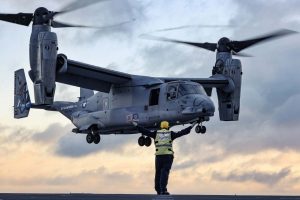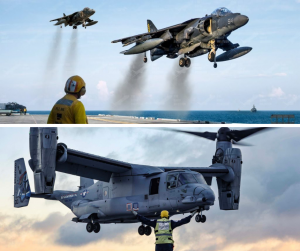American pilot lands British plane with previously unheard-of helicopter-like accuracy
When the US acquired the Harrier, they must have carefully obtained the technology (intellectual property), not a bad deal considering they already had the steam train, the jet engine, RADAR, and the groundwork for next to nothing.

The US designed Harriers. Grew out British pilot though. Another British pilot once lost communications and radar during carrier operations in the middle of the Atlantic, and managed to land his Harrier on top of shipping containers on a cargo ship before running out of fuel.

The captain was not happy, but they were compensated for the incident.

The United States Marine Corps (USMC) began crew training for the MV-22B Osprey in 2000 and fielded it in 2007, replacing their aging Boeing Vertol CH-46 Sea Knights. The U.S. Air Force (USAF) fielded their version of the tiltrotor, the CV-22B, in 2009.

Since entering service with the Marine Corps and Air Force, the Osprey has been deployed in various operations over Iraq, Afghanistan, Libya, and Kuwait. The U.S. Navy plans to use the CMV-22B for carrier onboard delivery missions starting in 2021.

The failure of Operation Eagle Claw, the Iran hostage rescue mission in 1980, led to the need for a new type of aircraft for “a new type of air combat, that could not only take off and land vertically but also carry out covert and deep special operations, and do so at speed.”

The U.S. Department of Defense initiated the JVX aircraft program in 1981, under the leadership of the U.S. Army leadership.

